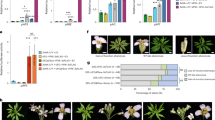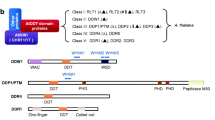Abstract
The development of floral reproductive organs requires the activity of plant MADS-box transcription factors (MBFs) belonging to the C function. The C function can only operate within a floral context, specified by MBFs belonging to the SEPALLATA class of proteins. Here we describe the specific interaction between a novel protein, MIP1, and C-function and SEPALLATA (SEP)-like MBFs. MIP1 is the first member of a new class of proteins unique to plants. None of the family members have yet been assigned a function. Motif searches reveal a leucine zipper domain within a conserved N-terminal region of MIP1. The leucine zipper lies within a region sufficient for interaction with plant MBFs. MIP1 interacts with a domain of plant MBFs that is analogous to the domain of animal and yeast MBFs involved in ternary complex formation. The MIP1 protein is predicted to localise to the nucleus and activates yeast reporter genes in vivo. MIP1 is expressed in the fourth whorl of the flower, in an overlapping temporal and spatial expression pattern with the C-function and SEP-like genes. Taken together, this suggests that MIP1 acts as a ternary complex factor specifically with C-function and SEP-like MBFs.
Similar content being viewed by others
References
Alvarez-Buylla, E.R., Pelaz, S., Liljegren, S.J., Gold, S.E., Burgeff, C., Ditta, G.S., de Pouplana, L.R., Martinez-Castilla, L. and Yanofsky, M.F. 2000. An ancestral MADS-box gene duplication occurred before the divergence of plants and animals. Proc. Natl. Acad. Sci. USA 97: 5328-5333.
Arabidopsis Genome Initiative. 2000. Analysis of the genome sequence of the flowering plant Arabidopsis thaliana. Nature 408: 796-815.
Bradley, D., Carpenter, R., Sommer, H., Hartley, N. and Coen, E. 1993. Complementary homeotic floral phenotypes result from opposite orientations of a transposon at the plena locus of Antirrhinum. Cell 72: 85-95.
Causier, B., Weir, I. and Davies, B. 1999. MADS-box factors in hermaphrodite flower development. In: C.C. Ainsworth (Ed.) Sex Determination in Plants, Bios Scientific Publishers, Oxford, pp. 1-23.
Causier, B. and Davies, B. 2002. Analysing protein-protein interactions with the yeast two-hybrid system. Plant Mol. Biol. 50: 855-870.
Coen, E.S. and Meyerowitz, E.M. 1991. The war of the whorls: genetic interactions controlling flower development. Nature 353: 31-37.
Davies, B. and Schwarz-Sommer, Zs. 1994. Control of floral organ identity by homeotic MADS-box transcription factors. Results Probl. Cell Differ. 20: 235-258.
Davies, B., Egea-Cortines, M., de Andrade Silva, E., Saedler, H. and Sommer, H. 1996. Multiple interactions amongst floral homeotic proteins. EMBO J. 15: 4330-4343.
Davies, B., Motte, P., Keck, E., Saedler, H., Sommer, H. and Schwarz-Sommer, Zs. 1999. PLENA and FARINELLI: redundancy and regulatory interactions between two Antirrhinum MADS-box factors controlling flower development. EMBO J. 18: 4023-4034.
Fan, H.Y., Hu, Y., Tudor, M. and Ma, H. 1997. Specific interactions between the K domains of AG and AGLs, members of the MADS domain family of DNA binding proteins. Plant J. 12: 999-1010.
Frishman, D. and Argos, P. 1995. Knowledge-based secondary structure assignment. Proteins 23: 566-579.
Gamboa, A., Paéz-Valencia, J., Acevedo, G.F., Vázquez-Moreno, L. and Alvarez-Buylla, R.E. 2001. Floral transcription factor AGAMOUS interacts in vitro with a leucine-rich repeat and an acid phosphatase protein complex. Biochem. Biophys. Res. Comm. 288: 1018-1026.
Garnier, J., Osguthorpe, D.J. and Robson, B. 1978. Analysis of the accuracy and implications of simple methods for predicting the secondary structure of globular proteins. J. Mol. Biol. 120: 97-120.
Grueneberg, D.A., Natesan, S., Alexandre, C. and Gilman, M.Z. 1992. Human and Drosophila homeodomain proteins that enhance the DNA-binding activity of serum response factor. Science 257:1089-1095.
Grueneberg, D.A., Henry, R.W., Brauer, A., Novina, C.D., Cheriyath, V., Roy, A.L. and Gilman, M. 1997. A multifunctional DNA-binding protein that promotes the formation of serum response factor/homeodomain complexes: identity to TFII-I. Genes Dev. 11: 2482-2493.
Gutierrez-Cortines, M.E. and Davies, B. 2000. Beyond the ABCs: ternary complex formation in the control of floral organ identity. Trends Plant Sci. 5: 471-476.
Hassler, M. and Richmond, T.J. 2001. The B-box dominates SAP-1-SRF interactions in the structure of the ternary complex. EMBO J. 20: 3018-3028.
Honma,T. and Goto, K. 2001. Complexes of MADS-box proteins are sufficient to convert leaves into floral organs. Nature 409: 525-529.
Jackoby, M., Weisshaar, B., Dröge-Laser, W., Vicente-Carbajosa, J., Tiedemann, J., Kroj, T. and Parcy, F. 2002. bZIP transcription factors in Arabidopsis. Trends Plant Sci. 7: 106-111.
Jones, D.T. 1999. Protein secondary structure prediction based on position-specific scoring matrices. J. Mol. Biol. 292: 195-202.
Keleher, C.A., Passmore, S. and Johnson, A.D. 1989. Yeast repressor ?2 binds to its operator cooperatively with yeast protein Mcm1. Mol. Cell Biol. 9: 5228-5230.
Kieffer, M. and Davies, B. 2001. Developmental programmes in floral organ formation. Sem. Cell Dev. Biol. 12: 373-380.
Liu, L., White, M.J. and MacRae, T.H. 1999. Transcription factors and their genes in higher plants. Eur. J. Biochem. 262: 247-257.
Masiero, S., Imbriano, C., Ravasio, F., Favaro, R., Pelucchi, N., Gorla, M.S., Mantovani, R., Colombo, L. and Kater, M.M. 2002. Ternary complex formation between MADS-box transcription factors and the histone fold protein NF-YB. J. Biol. Chem. 277: 26429-26435.
Nakai, K. and Kanehisa, M. 1992. A knowledge base for predicting protein localization sites in eukaryotic cells. Genomics 14: 897-911.
Pelaz, S., Ditta, G.S., Baumann, E., Wisman, E. and Yanofsky, M.F. 2000. B and C floral organ identity functions require SEPALLATA MADS-box genes. Nature 405: 200-203.
Pelaz, S., Tapia-López, R., Alvarez-Buylla, E.R. and Yanofsky, M.F. 2001a. Conversion of leaves into petals in Arabidopsis. Curr. Biol. 11: 182-184.
Pelaz, S., Gustafson-Brown, C., Kohalmi, S.E., Crosby, W.L. and Yanofsky, M.F. 2001b. APETALA1 and SEPALLATA3 interact to promote flower development. Plant J. 26: 385-394.
Riechmann, J.L., Krizek, B.A. and Meyerowitz, E.M. 1996. Dimerization specificity of Arabidopsis MADS domain homeotic proteins APETALA1, APETALA3, PISTILLATA, and AGAMOUS. Proc. Natl. Acad. Sci. USA 93: 4793-4798.
Riechmann, J.L. and Meyerowitz, E.M. 1997. Determination of floral organ identity by Arabidopsis MADS domain homeotic proteins AP1, AP3, PI and AG is independent of their DNAbinding specificity. Mol. Biol. Cell 8: 1243-1259.
Schwarz-Sommer, Zs., Huijser, P., Nacken, W., Saedler, H. and Sommer, H. 1990. Genetic control of flower development by homeotic genes in Antirrhinum majus. Science 250: 931-936.
Shore, P. and Sharrocks, A.D. 1995. The MADS-box family of transcription factors. Eur. J. Biochem. 229: 1-13.
Sommer, H., Beltrán, J.P., Huijser, P., Pape, H., Lönnig, W.E., Saedler, H. and Schwarz-Sommer, Zs. 1990. Deficiens, a homeotic gene involved in the control of flower morphogenesis in Antirrhinum majus: the protein shows homology to transcription factors. EMBO J. 9: 605-613.
Thompson, J.D., Higgins, D.G. and Gibson, T.J. 1994. Improving the sensitivity of progressive multiple sequence alignment through sequence weighting, position-specific gap penalties and weight matrix choice. Nucl. Acids Res. 22: 4673-4680.
Tröbner, W., Ramirez, L., Motte, P., Hue, I., Huijser, P., Lönnig, W.-E., Saedler, H., Sommer, H. and Schwarz-Sommer, Z. 1992. GLOBOSA: a homeotic gene which interacts with DEFICIENS in the control of Antirrhinum floral organogenesis. EMBO J. 11: 4693-4704.
West, A.G., Causier, B.E., Davies, B. and Sharrocks, A.D. 1998. DNA binding and dimerisation determinants of Antirrhinum majus MADS-box transcription factors. Nucl. Acids Res. 26: 5277-5287.
Zachgo, S. 2002. In situ hybridization. In: P.M. Gilmartin and C. Bowler (Eds.) Molecular Plant Biology, vol. 2, Oxford University Press, Oxford, pp. 41-63.
Zachgo, S., Saedler, H. and Schwarz-Sommer, Zs. 1997. Pollenspecific expression of DEFH125, a MADS-box transcription factor in Antirrhinum with unusual features. Plant J. 11: 1043-1050.
Author information
Authors and Affiliations
Corresponding author
Rights and permissions
About this article
Cite this article
Causier, B., Cook, H. & Davies, B. An Antirrhinum ternary complex factor specifically interacts with C-function and SEPALLATA-like MADS-box factors. Plant Mol Biol 52, 1051–1062 (2003). https://doi.org/10.1023/A:1025426016267
Issue Date:
DOI: https://doi.org/10.1023/A:1025426016267




